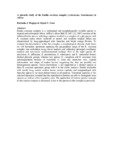Please use this identifier to cite or link to this item:
https://cris.library.msu.ac.zw//handle/11408/4465Full metadata record
| DC Field | Value | Language |
|---|---|---|
| dc.contributor.author | Mapaya, Ruvimbo J. | - |
| dc.contributor.author | Cron, Glynis V. | - |
| dc.date.accessioned | 2021-06-11T09:50:37Z | - |
| dc.date.available | 2021-06-11T09:50:37Z | - |
| dc.date.issued | 2016 | - |
| dc.identifier.issn | 0378-2697 | - |
| dc.identifier.issn | 1615-6110 | - |
| dc.identifier.uri | https://link.springer.com/article/10.1007/s00606-016-1294-6 | - |
| dc.identifier.uri | https://doi.org/10.1007/s00606-016-1294-6 | - |
| dc.identifier.uri | http://hdl.handle.net/11408/4465 | - |
| dc.description.abstract | Emilia coccinea complex is a widespread and morphologically variable species in tropical and subtropical Africa. Jeffrey’s (Kew Bull 52:205–212, 1997) revision of the African Emilia species with large capitula resulted in a complex of eight species with E. coccinea sensu stricto restricted to eastern and southern tropical Africa and characterised by long-appendaged style branches and bright orange flowers. To evaluate the delimitations within this complex, a morphological phenetic study based on 134 herbarium specimens spanning the geographical range of the E. coccinea complex was undertaken using cluster analysis and ordination (principal coordinates analysis and non-metric multidimensional scaling). Five of the eight species (E. emilioides, E. jeffreyana, E. praetermissa, E. subscaposa, and E. vanmeelii) formed distinct phenetic groups, whereas two species (E. caespitosa and E. coccinea) were indistinguishable because of variability in some key characters (viz., cypsela indumentum and shape of cauline leaves) suggesting that they are possibly one heterogeneous species. Emilia lisowskiana is not supported as a distinct species as three E. coccinea specimens group with it in the cluster analysis. Emilia emilioides with mostly long, narrow cauline leaves, narrow capitula, and unappendaged style branches apices is the most distinct taxon in all analyses. Univariate analyses of ten selected characters revealed that the reproductive features are able to distinguish some species, as well as a few vegetative ones. The application of various species concepts to this species complex is discussed. A key to the species in this complex is provided. | en_US |
| dc.language.iso | en | en_US |
| dc.publisher | Springer | en_US |
| dc.relation.ispartofseries | Plant Systematics and Evolution;Vol. 302: p. 703-720 | - |
| dc.subject | Cluster analysis | en_US |
| dc.subject | Ordination | en_US |
| dc.subject | Phenetics | en_US |
| dc.subject | Species concepts | en_US |
| dc.subject | Univariate analysis | en_US |
| dc.title | A phenetic study of the Emilia coccinea complex (Asteraceae, Senecioneae) in Africa | en_US |
| dc.type | Article | en_US |
| item.fulltext | With Fulltext | - |
| item.grantfulltext | open | - |
| item.openairetype | Article | - |
| item.languageiso639-1 | en | - |
| item.cerifentitytype | Publications | - |
| item.openairecristype | http://purl.org/coar/resource_type/c_18cf | - |
| Appears in Collections: | Research Papers | |
Files in This Item:
| File | Description | Size | Format | |
|---|---|---|---|---|
| Document1.pdf | Abstract | 63.96 kB | Adobe PDF |  View/Open |
Page view(s)
160
checked on Dec 17, 2025
Download(s)
44
checked on Dec 17, 2025
Google ScholarTM
Check
Items in MSUIR are protected by copyright, with all rights reserved, unless otherwise indicated.



